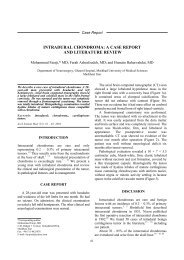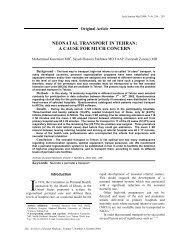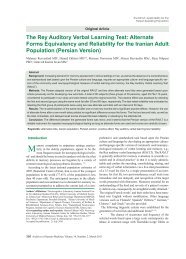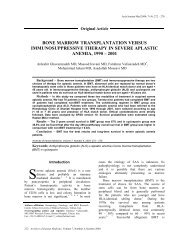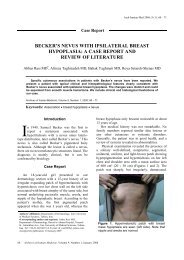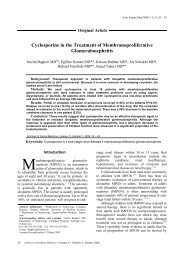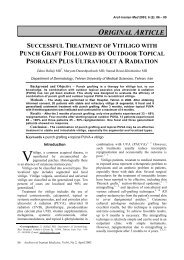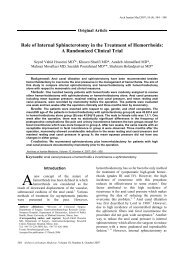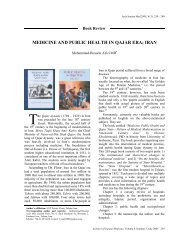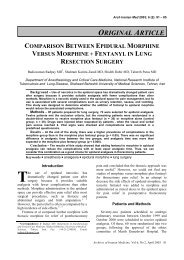Intravenous Injection of Diazepam to Cubital Vein Can be ...
Intravenous Injection of Diazepam to Cubital Vein Can be ...
Intravenous Injection of Diazepam to Cubital Vein Can be ...
Create successful ePaper yourself
Turn your PDF publications into a flip-book with our unique Google optimized e-Paper software.
Arch Iranian Med 2008; 11 (4): 469 – 471<br />
<strong>Intravenous</strong> <strong>Injection</strong> <strong>of</strong> <strong>Diazepam</strong> <strong>to</strong> <strong>Cubital</strong> <strong>Vein</strong> <strong>Can</strong> <strong>be</strong><br />
Complicated by Accidental Intra-Arterial Penetration and Gangrene<br />
Fardin Mirza<strong>to</strong>looei MD • *, Ahmadreza Afshar MD*<br />
We present an elbow disarticulation due <strong>to</strong> accidental intra-arterial injection <strong>of</strong> diazepam.<br />
Considering the risk <strong>of</strong> inadvertent and accidental intra-arterial injection <strong>of</strong> diazepam and its<br />
subsequent severe sequelae that are reported in the literature, we emphasize that intravenous<br />
diazepam should <strong>be</strong> administered with more hesitancy and care.<br />
Archives <strong>of</strong> Iranian Medicine, Volume 11, Num<strong>be</strong>r 4, 2008: 469 – 471.<br />
Keywords: Amputation • complications • diazepam<br />
Introduction<br />
iazepam is a well- known drug used in<br />
many disorders such as convulsion and<br />
anxiety. Despite its safety regarding<br />
systemic side effects, its local complications can <strong>be</strong><br />
catastrophic. Many cases with accidental intraarterial<br />
injection <strong>of</strong> diazepam have <strong>be</strong>en reported<br />
in the literature. 1–5 D<br />
Because the treatment <strong>of</strong> this<br />
incident is empirical, every effort should <strong>be</strong> taken<br />
<strong>to</strong> prevent its occurrence.<br />
Case Report<br />
A 26-year-old woman presented with headache<br />
and mild anxiety <strong>to</strong> emergency department at 3<br />
a.m. Headache had <strong>be</strong>en started from some hours<br />
ago. She was a known case <strong>of</strong> multiple sclerosis<br />
and had <strong>be</strong>en treated with ergotamine for the last<br />
five years. She had no his<strong>to</strong>ry <strong>of</strong> psychologic<br />
problems and had not taken any other drugs in the<br />
last month.<br />
Vital signs were normal and general physical<br />
examination was unremarkable. A diazepam vial<br />
was ordered by the physician <strong>to</strong> <strong>be</strong> injected<br />
intravenously. Assuming the tip <strong>of</strong> the needle <strong>to</strong> <strong>be</strong><br />
Authors’ affiliation: *Orthopedic Ward, Motahari Hospital,<br />
Urmia University <strong>of</strong> Medical Sciences, Urmia, Iran.<br />
•Corresponding author and reprints: Fardin Mirza<strong>to</strong>looei MD,<br />
Orthopedic Ward, Motahari Hospital, No.34, Second 16m St.,<br />
Amanat Ave., Emamat Blvd., Urmia 57199, Iran.<br />
Tel:+98-441-337-3606, E-mail: fardin_<strong>to</strong>louei@yahoo.com<br />
Accepted for publication: 22 June 2007<br />
Case Report<br />
in a vein at the anterior aspect <strong>of</strong> the right<br />
antecubital fossa, 10 mg diazepam was injected<br />
slowly by the nurse in-charge. The patient<br />
complained <strong>of</strong> severe knocking pain in the entire<br />
right forearm during the injection. Despite this<br />
pain, the injection was continued <strong>to</strong> the end and the<br />
patient discharged with some analgesics. Three<br />
hours later she was referred again <strong>to</strong> the same<br />
physician and received some more analgesics. At<br />
that time the patient was able <strong>to</strong> move her fingers<br />
but had paresthesia and severe pain. Seven hours<br />
later she was visited by the chief resident at the<br />
clinic <strong>of</strong> surgery and was admitted <strong>to</strong> the<br />
department <strong>of</strong> surgery <strong>be</strong>cause <strong>of</strong> pain, severe<br />
swelling, pallor, and absence <strong>of</strong> radial and ulnar<br />
pulses. She underwent an emergency vascular<br />
exploration for surgical help and 10 mL lidocaine<br />
(1%) was injected around the brachial artery. She<br />
was also heparinized. Seventy-two hours later an<br />
elbow disarticulation was done by an orthopedic<br />
surgeon <strong>be</strong>cause <strong>of</strong> dark skin and gangrene (Figure<br />
1). Surgical exploration revealed that the tissues in<br />
the antecubital fossa and even a little bit proximal<br />
<strong>to</strong> the injection site were necrotic (Figure 2).<br />
His<strong>to</strong>pathologic examination confirmed infiltration<br />
<strong>of</strong> inflamma<strong>to</strong>ry cells and thrombosis.<br />
Discussion<br />
Several cases with irreversible complications <strong>of</strong><br />
accidental intra-arterial injection <strong>of</strong> diazepam have<br />
<strong>be</strong>en reported in the literature . 1–3<br />
Archives <strong>of</strong> Iranian Medicine, Volume 11, Num<strong>be</strong>r 4, July 2008 469
Figure 1. Three days after the injection; the limb is<br />
gangrenous.<br />
<strong>Diazepam</strong> is a well-known and effective drug in<br />
various diseases, but one should <strong>be</strong> aware <strong>of</strong> the<br />
fact that its intravenous injection could <strong>be</strong><br />
catastrophic. Although the rate <strong>of</strong> thrombophlebitis<br />
increases with intravenous injection <strong>of</strong> diazepam, 6<br />
the main problem is its extravasation in<strong>to</strong> the<br />
brachial artery where it can obliterate the blood<br />
flow through thrombus formation.<br />
The pathogenesis <strong>of</strong> the thrombosis and<br />
gangrene that follow intra-arterial injection <strong>of</strong><br />
diazepam is not fully unders<strong>to</strong>od; however, spasm<br />
<strong>of</strong> the artery and crystallization <strong>of</strong> the drug are<br />
among the main suggested causes. 4 Thrombosis<br />
and arterial obliteration can occur several hours<br />
later, so the presence <strong>of</strong> distal pulses does not<br />
indicate that no tragedy is going <strong>to</strong> happen. 5<br />
In all cases presented in the literature, the<br />
patients had complained <strong>of</strong> a severe pain radiating<br />
<strong>to</strong> distal parts. 1–3 Hence, we strongly suggest <strong>to</strong><br />
s<strong>to</strong>p the injection if pain occurs. Accepting the<br />
aforementioned pathogenesis theory, the <strong>be</strong>st<br />
Figure 2. Reveals that all tissues including brachial<br />
artery are necrotic.<br />
470<br />
Archives <strong>of</strong> Iranian Medicine, Volume 11, Num<strong>be</strong>r 4, July 2008<br />
<strong>Intravenous</strong> injection <strong>of</strong> diazepam<br />
strategy <strong>to</strong> confront this event is <strong>to</strong> decrease the<br />
concentration <strong>of</strong> the drug. It is recommended that<br />
the needle <strong>to</strong> <strong>be</strong> left in place and the artery flushed<br />
with a vasodila<strong>to</strong>r such as papaverine or procain. 7<br />
Heparin is manda<strong>to</strong>ry <strong>be</strong>cause it inhibits the<br />
coagulation cascade. Sympathec<strong>to</strong>my, nerve block,<br />
steroids, hyperbaric oxygen, and strep<strong>to</strong>kinase<br />
have <strong>be</strong>en suggested as treatment modalities in the<br />
literature, but they have not improved the eventual<br />
outcome. 8,9,10 Care should <strong>be</strong> taken <strong>to</strong> determine<br />
that any injection will not <strong>be</strong> intra-arterial and that<br />
perivascular extravasation will not take place.<br />
Errors in technique <strong>of</strong> injection and<br />
compromised care as a consequence <strong>of</strong><br />
overcrowded hospitals can enhance the probability<br />
<strong>of</strong> accidental intra-arterial injection. 1,3,4,11 In this<br />
particular case, none <strong>of</strong> the patient’s- related risk<br />
fac<strong>to</strong>rs such as arterial anomalies and prematurity,<br />
which usually exist in other reported cases 11,7 were<br />
present. It seems that lack <strong>of</strong> adequate knowledge<br />
<strong>of</strong> the physician and the nurse regarding<br />
complications <strong>of</strong> diazepam played the important<br />
role in development <strong>of</strong> this complication. The<br />
nurse who was injecting the diazepam was also<br />
overburdened in an extremely busy situation.<br />
We emphasize on more hesitancy in<br />
intravenous diazepam injection in emergency<br />
rooms and more vigilance in recognizing the<br />
immediate complications.<br />
References<br />
1 Derakhshan M R. Amputation due <strong>to</strong> inadvertent intraarterial<br />
diazepam injection. Irn J Med Sci. 2000; 25:<br />
84 – 86.<br />
2 Gori F, Moretti I, Mosca S, Pasqualucci A. Intra-arterial<br />
diazepam. Treatment and evaluation <strong>of</strong> a case. Minerva<br />
Anesthesiol. 1991; 57: 445.<br />
3 Joist A, Ti<strong>be</strong>sku CO, Neu<strong>be</strong>r M, Frerichmann U, Joosten<br />
U. Gangrene <strong>of</strong> the fingers caused by accidental intraarterial<br />
injection <strong>of</strong> diazepam [in German]. Dtsch Med<br />
Wochenschr. 1999; 124: 755 – 758.<br />
4 Knill RL, Evans D. Pathogenesis <strong>of</strong> gangrene following<br />
intra-arterial injection <strong>of</strong> drugs: a new hypothesis. <strong>Can</strong><br />
Anesth Soc J. 1975; 22: 637 – 646.<br />
5 Myrddin R, Dormandy J. Accidental intra-arterial<br />
injection <strong>of</strong> diazepam. Br Med J. 1980; 281: 289 – 290.<br />
6 Schou- Olesen A, Huttel MS. Local reactions <strong>to</strong> IV<br />
diazepam in three different formulations. Br J Anaesth.<br />
1980; 52: 609 – 611.<br />
7 Sen S, Chini NE, Brown MJ. Complications after<br />
unintentional intra-arterial injection <strong>of</strong> drugs: risks,<br />
outcomes, and management strategies. Mayo Clin Proc.<br />
2005; 80: 783 – 785.<br />
8 Bhabra MS, Meshikhes AN, Thopson GJL, Craig P,<br />
Oarrot NR. Intraarterial temazepam: an important cause<br />
<strong>of</strong> limb ischemia in intravenous drug abusers. Eur J Vasc
Surg. 1994; 8: 240 – 242.<br />
9 Copoper JC, Griffiths AB, Jones AB, Raftery AT.<br />
Accidental intra-arterial injection in drugs addicts. Eur J<br />
Vasc Surg. 1992; 6: 430 – 433.<br />
10 Gold<strong>be</strong>rg I, Bahar A, Yosipovitch Z. Gangrene <strong>of</strong> the<br />
upper extremity following intra-arterial injection <strong>of</strong><br />
drugs. A case report and review <strong>of</strong> the literature. Clin<br />
F. Mirza<strong>to</strong>looei, A. Afshar<br />
Orthop Relat Res. 1984; (188): 223 – 229.<br />
11 Arquilla B, Gupta R, Gernshiemer J, Fischer M. Acute<br />
arterial spasm in an extremity caused by inadvertent<br />
intra-arterial injection successfully treated in the<br />
emergency department. J Emerg Med. 2000; 19:<br />
139 – 143.<br />
Archives <strong>of</strong> Iranian Medicine, Volume 11, Num<strong>be</strong>r 4, July 2008 471



